-
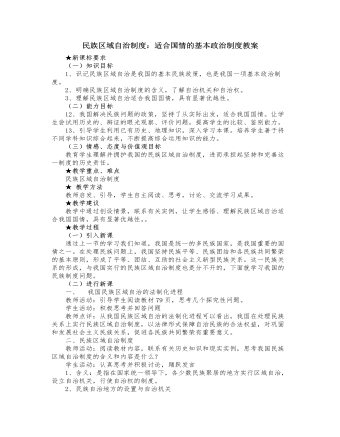
人教版高中政治必修2民族区域自治制度:适合国情的基本政治制度教案
1、有利于维护国家的统一和安全民族区域自治以领土完整、国家统一为前提和基础,是国家集中统一领导与民族区域自治的有机结合。增强了中华民族的凝聚力,使各族人民特别是少数民族人民把热爱民族与热爱祖国的感情结合起来,自觉担负起捍卫祖国统一、保卫边疆的光荣职责。2、有利于保障少数民族人民当家作主的权利民族自治地方充分享有自治权利。自主管理本地内部事务,满足了少数民族人民积极参加国家政治生活的愿望。3、有利于发展平等、团结、互助的社会主义新型民族关系民族自治地方以一个或几个少数民族为主体,同时包括当地居住的汉族和其他少数民族,各族人民和各族干部之间联系更加密切,逐步消除了历史上遗留下来的民族隔阂。4、有利于促进社会主义现代化事业的发展自治机关能够结合本民族、本地区特点,把少数民族的特殊利益与国家的整体利益协调起来,充分发挥各自的特长和优势,调动各族人民参加国家建设的积极性、创造性。
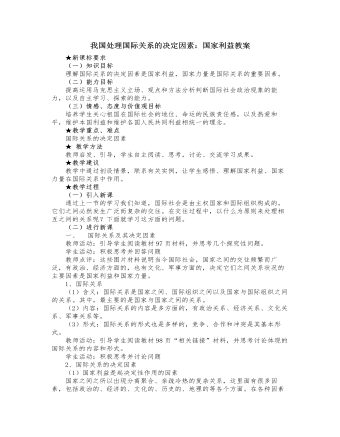
人教版高中政治必修2我国处理国际关系的决定因素:国家利益教案
从国际法角度看,国际社会的每一个主权国家应该是一律平等的,但是,在现实的国际关系中,每个国家的国际地位、国际影响力,历来都是由国家力量决定的。国家力量发生变化,也会引起国际关系的变化。经济、科技落后,军力不强,国内政局不安,它的国际影响力、参与力就不强。正因为如此,某些发达国家往往以其强大的国家力量为后盾,推行霸权主义、强权政治。二、维护我国的国家利益教师活动:阅读教材第100页内容,思考讨论为什么要维护我国的国家利益?我国的国家利益包括哪些内容?学生活动:认真思考并积极讨论,踊跃发言1、原因我国是人民当家作主的社会主义国家,国家利益与人民的根本利益相一致。维护我国的国家利益就是维护广大人民的根本利益,具有正当性和正义性。2、内容我国国家利益的主要内容包括:安全利益,如国家的统一、独立、主权和领土完整;政治利益,如我国政治、经济、文化等制度的巩固;经济利益,如我国资源利用的效益、经济活动的利益和国家物质基础的增强等。
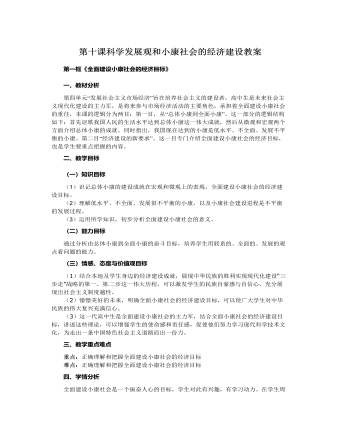
人教版高中政治必修1第十课科学发展观和小康社会的经济建设教案
一、教材分析第四单元“发展社会主义市场经济”旨在培养社会主义的建设者,高中生是未来社会主义现代化建设的主力军,是将来参与市场经济活动的主要角色,承担着全面建设小康社会的重任,本课的逻辑分为两目:第一目,从“总体小康到全面小康”。这一部分的逻辑结构如下:首先讴歌我国人民的生活水平达到总体小康这一伟大成就,然后从微观和宏观两个方面介绍总体小康的成就。同时指出,我国现在达到的小康是低水平、不全面、发展不平衡的小康。第二目“经济建设的新要求”。这一目专门介绍全面建设小康社会的经济目标,也是学生要重点把握的内容。二、教学目标(一)知识目标(1)识记总体小康的建设成就在宏观和微观上的表现,全面建设小康社会的经济建设目标。(2)理解低水平、不全面、发展很不平衡的小康,以及小康社会建设进程是不平衡的发展过程。(3)运用所学知识,初步分析全面建设小康社会的意义。
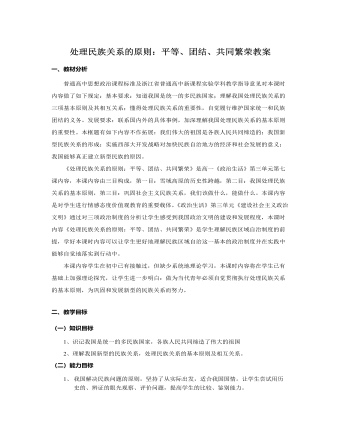
人教版高中政治必修2处理民族关系的原则:平等、团结、共同繁荣教案
一、教材分析普通高中思想政治课程标准及浙江省普通高中新课程实验学科教学指导意见对本课时内容做了如下规定:基本要求:知道我国是统一的多民族国家;理解我国处理民族关系的三项基本原则及其相互关系;懂得处理民族关系的重要性,自觉履行维护国家统一和民族团结的义务。发展要求:联系国内外的具体事例,加深理解我国处理民族关系的基本原则的重要性。本框题有如下内容不作拓展:我们伟大的祖国是各族人民共同缔造的;我国新型民族关系的形成;实施西部大开发战略对加快民族自治地方的经济和社会发展的意义;我国能够真正建立新型民族的原因。《处理民族关系的原则:平等、团结、共同繁荣》是高一《政治生活》第三单元第七课内容,本课内容由三目构成,第一目:雪域高原的历史性跨越,第二目:我国处理民族关系的基本原则,第三目:巩固社会主义民族关系,我们该做什么,能做什么。
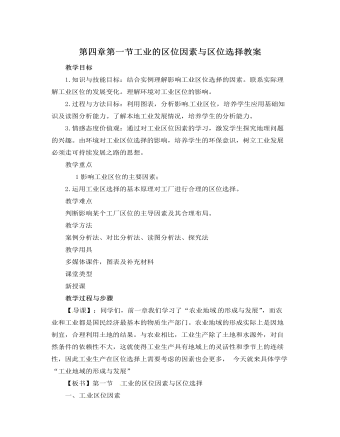
人教版新课标高中地理必修2第四章第一节工业的区位因素与区位选择教案
教学目标1.知识与技能目标:结合实例理解影响工业区位选择的因素。联系实际理解工业区位的发展变化。理解环境对工业区位的影响。2.过程与方法目标:利用图表,分析影响 工业区位,培养学生应用基础知识及读图分析能力。了解本地工业发展情况,培养学生的分析能力。3.情感态度价值观:通过对工业区位因素的学习,激发学生探究地理问题的兴趣。由环境对工业区位选择的影响,培养学生的环保意识,树立工业发展必须走可持续发展之路的思想。教学重点1影响工业区位的主要因素;2.运用工业区选择的基本原理对工厂进行合理的区位选择。教学难点 判断影响某个工厂区位的主导因素及其合理布局。教学方法 案例分析法、对比分析法、读图分析法、探究法教学用具 多媒体课件,图表及补充材料课堂类型
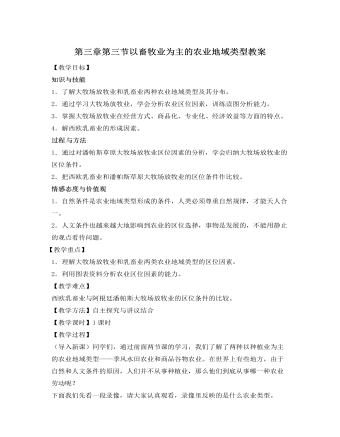
人教版新课标高中地理必修2第三章第三节以畜牧业为主的农业地域类型教案
知识与技能1.了解大牧场放牧业和乳畜业两种农业地域类型及其分布。2.通过学习大牧场放牧业,学会分析农业区位因素,训练读图分析能力。3.掌握大牧场放牧业在经营方式、商品化、专业化、经济效益等方面的特点。4.解西欧乳畜业的形成因素。过程 与方法1.通过对潘帕斯草原大牧场放牧业区位因素的分析,学会归纳大牧场放牧业的区位条件。2.把西欧乳畜业和潘帕斯草原大牧场放牧业的区位条件作比较。情感态度与价值观1.自然条件是农业地域类型形成的条件,人类必须尊重自然规律,才能天人合一。2.人文条件也越来越大地影响到农业的区位选择,事物是发展的,不能用静止的观点看待问题。【教学重点】1.理解大牧场放牧业和乳畜业两类农业地域类型的区位因素。2.利用图表资料分析农业区位因素的能力。
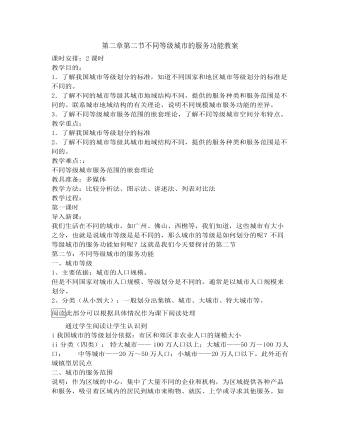
人教版新课标高中地理必修2第二章第二节不同等级城市的服务功能教案
1.了解我国城市等级划分的标准,知道不同国家和地区城市等级划分的标准是不同的。2.了解不同的城市等级其城市地域结构不同,提供的服务种类和服务范围是不同的。联系城市地域结构的有关理论,说明不同规模城市服务功能的差异。3.了解不同等级城市服务范围的嵌套理论,了解不同等级城市空间分布特点。教学重点:1.了解我国城市等级划分的标准2.了解不同的城市等级其城市地域结构不同,提供的服务种类和服务范围是不同的。教学难点::不同等级城市服务范围的嵌套理论教具准备:多媒体教学方法:比较分析法、图示法、讲述法、列表对比法教学过程:第一课时导入新课:我们生活在不同的城市,如广州、佛山、西樵等,我们知道,这些城市有大小之分,也就是说城市等级是是不同的,那么城市的等级是如何划分的呢?不同等级城市的服务功能如何呢?这就是我们今天要探讨的第二节
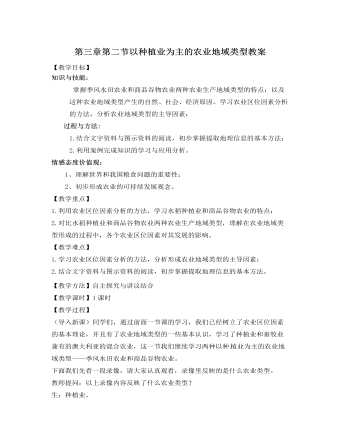
人教版新课标高中地理必修2第三章第二节以种植业为主的农业地域类型教案
【教学重点】1.利用农业区位因素分析的方法,学习水稻种植业和商品谷物农业的特点;2.对比水稻种植业和商品谷物农业两种农业生产地域类型,理解在农业地域类型形成的过程中,各个农业区位因素对其发展的影响。【教学难点】1.学习农业区位因素分析的方法,分析形成农业地域类型的主导因素;2.结合文字资料与图示资料的阅读,初步掌握提取地理信息的基本方法。【教学方法】自主探究与讲议结合【教学课时】1课时【教学过程】(导入新课)同学们,通过前面一节课的学习,我们已经树立了农业区位因素的基本理论,并且有了农业地域类型的一些基本认识,学习了种植业和畜牧业兼有的澳大利亚的混合农业,这一节我们继续学习两种以种 植业为主的农业地域类型——季风水田农业和商品谷物农业。
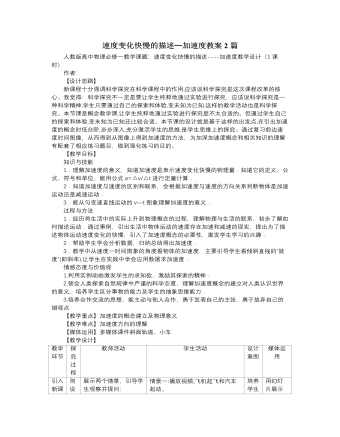
人教版新课标高中物理必修1速度变化快慢的描述─加速度教案2篇
【设计思路】新课程十分强调科学探究在科学课程中的作用,应该说科学探究是这次课程改革的核心。我觉得:科学探究不一定是要让学生纯粹地通过实验进行探究,应该说科学探究是一种科学精神,学生只要通过自己的探索和体验,变未知为已知,这样的教学活动也是科学探究。本节课是概念教学课,让学生纯粹地通过实验进行探究是不太合适的。但通过学生自己的探索和体验,变未知为已知还比较合适。本节课的设计就是基于这样的出发点,在引出加速度的概念时低台阶,步步深入,充分激活学生的思维,是学生思维上的探究。通过复习前边速度时间图像,从而得到从图像上得到加速度的方法,为加深加速度概念和相关知识的理解有配套了相应练习题目,做到强化练习的目的。【教学目标】知识与技能1.理解加速度的意义,知道加速度是表示速度变化快慢的物理量.知道它的定义、公式、符号和单位,能用公式a=△v/△t进行定量计算.2.知道加速度与速度的区别和联系,会根据加速度与速度的方向关系判断物体是加速运动还是减速运动.3.能从匀变速直线运动的v—t图象理解加速度的意义.
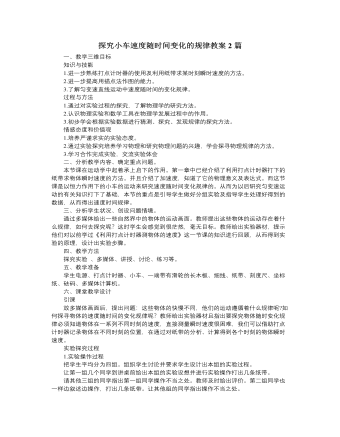
人教版新课标高中物理必修1探究小车速度随时间变化的规律教案2篇
三、作出速度-时间图像(v-t图像)1、确定运动规律最好办法是作v-t图像,这样能更好地显现物体的运动规律。2、x y x1 x2 y2 y1 0讨论如何在本次实验中描点、连线。(以时间t为横轴,速度v为纵轴,建立坐标系,选择合适的标度,把刚才所填表格中的各点在速度-时间坐标系中描出。注意观察和思考你所描画的这些点的分布规律,你会发现这些点大致落在同一条直线上,所以不能用折线连接,而用一根直线连接,还要注意连线两侧的点数要大致相同。)3、若出现了个别明显偏离绝大部分点所在直线的点,该如何处理?(对于个别明显偏离绝大部分点所在直线的点,我们可以认为是测量误差过大、是测量中出现差错所致,将它视为无效点,但是在图像当中仍应该保留,因为我们要尊重实验事实,这毕竟是我们的第一手资料,是原始数据。)4、怎样根据所画的v-t图像求加速度?(从所画的图像中取两个点,找到它们的纵、横坐标(t1,v1)、(t2,v2),然后代入公式,求得加速度,也就是直线的斜率。在平面直角坐标系中,直线的斜率
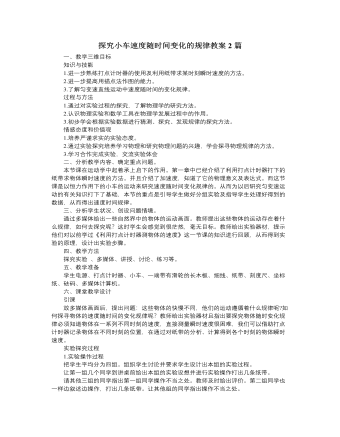
人教版新课标高中物理必修1探究小车速度随时间变化的规律教案2篇
3、若出现了个别明显偏离绝大部分点所在直线的点,该如何处理?(对于个别明显偏离绝大部分点所在直线的点,我们可以认为是测量误差过大、是测量中出现差错所致,将它视为无效点,但是在图像当中仍应该保留,因为我们要尊重实验事实,这毕竟是我们的第一手资料,是原始数据。)4、怎样根据所画的v-t图像求加速度?(从所画的图像中取两个点,找到它们的纵、横坐标(t1,v1)、(t2,v2),然后代入公式,求得加速度,也就是直线的斜率。在平面直角坐标系中,直线的斜率四、实践与拓展例1、在探究小车速度随时间变化规律的实验中,得到一条记录小车运动情况的纸带,如图所示。图中A、B、C、D、E为相邻的计数点,相邻计数点的时间间隔为T=0.1s。⑴根据纸带上的数据,计算B、C、D各点的数据,填入表中。

新人教版高中英语必修3Unit 3 Diverse Cultures教学设计三
The price is the same as(the price was)before the war.价格与战前相同。(4)定语从句中的“关系代词+助动词be”可以省略。The ticket(that/which was)booked by his sister has been sent to him.他妹妹订的那张票已送到了他那里。Step 5 PracticeActivity 3(1) Guide students to complete the four activities in the Using Structures part of exercise book, in which activities 1 and 2 focus on ellipsis in dialogue answers, activity 3 focus on signs and headlines, two typical situations where ellipsis is used, and activity 4 focus on ellipsis in diary, an informal style.(2) Combine the examples in the above activities, ask students to summarize the omitted situations in groups, and make their own summary into a poster, and post it on the class wall after class to share with the class.(This step should give full play to the subjectivity of students, and teachers should encourage students to conclude different ellipsis phenomena according to their own understanding, they can conclude according to the different parts omitted in the sentence.)Step 6 Homework1. Understand and master the usages of ellipsis;2. Finish the other exercises in Using structures of Workbook.1、通过本节内容学习,学生是否理解和掌握省略的用法;2、通过本节内容学习,学生能否根据上下文语境或情景恢复句子中省略的成分,体会使用省略的效果;3、通过本节内容学习,学生能否独立完成练习册和导学案中的相关练习。

新人教版高中英语必修3Unit 3 Diverse Cultures教学设计二
(2)Consolidate key vocabulary.Ask the students to complete the exercises of activity 6 by themselves. Then ask them to check the answers with their partners.(The first language:Damage of the 1906 San Francisco earthquake and fire.A second language: Yunnan - one of the most diverse provinces in China).Step 5 Language points1. The teacher asks the students to read the text carefully, find out the more words and long and difficult sentences in the text and draw lines, understand the use of vocabulary, and analyze the structure of long and difficult sentences.2. The teacher explains and summarizes the usage of core vocabulary and asks the students to take notes.3. The teacher analyzes and explains the long and difficult sentences that the students don't understand, so that the students can understand them better.Step 6 Homework1. Read the text again, in-depth understanding of the text;2. Master the use of core vocabulary and understand the long and difficult sentences.3. Complete relevant exercises in the guide plan.1、通过本节内容学习,学生是否理解和掌握阅读文本中的新词汇的意义与用法;2、通过本节内容学习,学生能否结合文本特点了解文章的结构和作者的写作逻辑;3、通过本节内容学习,学生能否了解旧金山的城市风貌、文化特色,以及加利福尼亚州的历史,体会多元文化对美国的影响。

新人教版高中英语必修3Unit 3 Diverse Cultures教学设计四
该板块的活动主题是“介绍一个有显著文化特征的地方”( Describe a place with distinctive cultural identity)。该板块通过介绍中国城继续聚焦中国文化。本单元主题图呈现的是旧金山中国城的典型景象, Reading and Thinking部分也提到中国城,为该板块作铺垫。介绍中国城的目的主要是体现中国文化与美国多元文化的关系,它是美国多元文化的重要组成部分。中国城也是海外华人的精神家园和传播中国文化的重要窗口,外国人在中国城能近距离体验中国文化。1. Read the text to understand the cultural characteristics of Chinatown in San Francisco and the relationship between Chinese culture and American multiculturalism;2. Through reading, learn to comb the main information of the article, understand the author's writing purpose and writing characteristics;3. Learn to give a comprehensive, accurate, and organized description of the city or town you live in;Learn to revise and evaluate your writing.Importance:1. Guide the students to read the introduction of Chinatown in San Francisco and grasp its writing characteristics;2. Guide students to introduce their city or town in a comprehensive, accurate and organized way;3. Learn to comb the main information of the article, understand the author's writing purpose, and master the core vocabulary.

新人教版高中英语必修3Unit 3 Diverse Cultures教学设计一
Activity 81.Grasp the main idea of the listening.Listen to the tape and answer the following questions:Who are the two speakers in the listening? What is their relationship?What is the main idea of the first part of the listening? How about the second part?2.Complete the passage.Ask the students to quickly review the summaries of the two listening materials in activity 2. Then play the recording for the second time.Ask them to complete the passage and fill in the blanks.3.Play the recording again and ask the students to use the structure diagram to comb the information structure in the listening.(While listening, take notes. Capture key information quickly and accurately.)Step 8 Talking Activity 91.Focus on the listening text.Listen to the students and listen to the tape. Let them understand the attitudes of Wu Yue and Justin in the conversation.How does Wu Yue feel about Chinese minority cultures?What does Justin think of the Miao and Dong cultures?How do you know that?2.learn functional items that express concerns.Ask students to focus on the expressions listed in activity. 3.And try to analyze the meaning they convey, including praise (Super!).Agree (Exactly!)"(You're kidding.!)Tell me more about it. Tell me more about it.For example, "Yeah Sure." "Definitely!" "Certainly!" "No kidding!" "No wonder!" and so on.4.Ask the students to have conversations in small groups, acting as Jsim and his friends.Justin shares his travels in Guizhou with friends and his thoughts;Justin's friends should give appropriate feedback, express their interest in relevant information, and ask for information when necessary.In order to enrich the dialogue, teachers can expand and supplement the introduction of Miao, dong, Lusheng and Dong Dage.After the group practice, the teacher can choose several groups of students to show, and let the rest of the students listen carefully, after listening to the best performance of the group, and give at least two reasons.

人教版高中英语必修3Astronomy the science of the stars说课稿3篇
Step 2 Pre-listeningAfter students finish their discussion, I will show a picture of Newton and ask them: Who is him? What is he famous for? Could you find out some words to describe him? Maybe students will answer that he is genius for his finding of theGravitation, making a great contribution to the progress of human being. At that time I will show another two pictures of Einstein and Hawking, letting students guess who they are and write down their idea about the Gravitation. For I have arranged them to search more information about the gravity before this class, Students have beenfamiliar with the topic and will not be afraid about this abstract conception, which is helpful for their listening.Step 3 While-listeningIn this step, students will be required to listen the material for three times. The first and listening is extensive listening and the second and third listening is intensive listening. In the first time, They are required to listen a material including Part 1 and Part 2 and choose the best summary of the listening text. After they choose the right answer, They also need work in group to explain what is wrong with the others. Then I will make a conclusion that we should pay attention to the first paragraph and last paragraph and some keys to get the main idea. By doing this, their capacity of generalization will have a great improvement.Before the second listening, I will ask students to scan the blank on the power point quickly and ask them to note down some key words .Then ask them to listen to the Part 1again and fill the first column of the chart. Maybe some students just show the ideas of these three scientists an still can’t catch their development of gravity. Therefore, I will ask them to listen to Part 2 again and fill in the rest. After finish the listening, I will give them ten minutes to discuss with their partner. I will also guidethem to improve their answers when they discuss with others.

人教版高中英语必修3Festivals around the World说课稿3篇
Teaching plan for Unit 1 book3Good morning, teachers. It’s my great pleasure to be here because I can share my lesson with you and I can learn a lot from it. I’ll begin my lesson from the following four parts, the teaching material, the teaching methods, the studying methods and the teaching procedure.Firstly, let me talk about the teaching material. The content of my lesson is the reading passage festivals and celebrations of Unit 1 Festivals around the world. This passage is about festivals and celebrations. By studying this passage, we’ll enable the students to know that festivals exit everywhere, and many of festivals in different countries celebrate similar ideas. As we all know, the reading passage is the center of each unit. If the Ss can learn it well, it will be helpful to make the Ss learn the rest of this unit.After studying the teaching material, I think the teaching aims are as the followings:1. Knowledge aims:(1) The Ss can master the usage of the important words andexpressions.(2)The Ss can use the __________________ (grammar) in the proper situation.Make students know about the festivals all over the world and the detail of the festivals, such as origin, content, and the date of the holiday festivals.2. Ability aims:(1) Students can talk about festivals and celebrations in English(2) To improve the student’s reading ability, especially their skimming and scanning ability.3. Emotion aims:Make the Ss know about the foreign festivals, and respect other countries’ custom.Next, let’s come to the important points and the difficult points.The important point is how to make the Ss understand the text better and the difficult point is how can they talk about it. secondly, Teaching Methods:1. task-based Language Teaching2. Computer assisted language teaching.3. question-and–answer methodThirdly, Studying Methods:

人教版高中英语必修3The million pound bank note说课稿3篇
在接下来的细读环节,我套用了高考对阅读理解的考查方式设置了5个问题,分别为三个推理判断题,一个细节题和一个主旨大意题。学生需要对文章的内容进行分析、归纳、推理、猜测等高级思维活动才能做出正确的回答。【设计意图】这一过程是对学生进行细读的训练,培养学生获取特定信息和挖掘文章深层次信息的能力。第三环节:Intensive-reading (精读) 15′第三个环节精读,既是最重要的环节,也是突破本课重难点的关键。首先,让学生思考剧本中人物看到百万英镑前后的态度发生了怎样的变化。其次,让学生仔细阅读文章,找出可以表现人物态度变化的具体的语言和动作。最后,让学生总结人物的态度发生变化的根本原因是什么,从而引出Money Talks, 供学生思考。【设计意图】通过一系列的活动培养学生学习从人物的语言和动作探究人物的心理,使学生进一步体会戏剧语言的魅力,从而对文章背后所反映的社会问题进行思考,也为下一步的讨论环节做好铺垫。

新人教版高中英语必修3Unit 2 Morals and Virtues教学设计三
The joke set her crying.这个玩笑使她哭起来。Step 5 ReadingActivity 31. Students read the small text in activity 3. The teacher provides several small questions to check whether students understand the content of the text and the ideographic function of the -ing form in the text.*Where are those people?*Why did Dr Bethune come to China?*How did he help the Chinese people during the war?*What did Chairman Mao Zedong say about him?2. Ss try to rewrite some sentences using the -ing form. Then check the answers. When checking the answers, the teacher can ask different students to read the rewritten sentences and give comments.Answers:1. he became very interested in medicine, deciding to become a doctor.2. …after hearing that many people were dying in the war.3. Helping to organise hospitals, he taught doctors and nurses, and showed people how to give first aid./ He helped to organise hospitals, teaching doctors and nurses, and showing people how to give first aid.4. …praising Dr Bethune as a hero to be remembered in China.Step 6 PracticeActivity 4Students complete grammar activities 2 and 3 on page 69 of the workbook.Step 6 Homework1. Understand and master the functions and usage of the -ing form;2. Finish the other exercises in Using structures.1、通过本节内容学习,学生是否理解和掌握动词-ing形式作宾语补足语语和状语语的功能和意义;2、通过本节内容学习,学生能否正确使用动词-ing形式描述人物的行为、动作及其经历;3、通过本节内容学习,学生能否独立完成练习册和导学案中的相关练习。

新人教版高中英语必修3Unit 2 Morals and virtues教学设计一
(2) students are divided into groups according to the requirements of activity 3. Each student shares a story of personal experience or hearing-witnessing kindness, and then selects the most touching story in the group and shares it with the whole class. Before the students share the story, the teacher can instruct them to use the words and sentence patterns in the box to express. For example, the words in the box can be classified:Time order: first of all, then, after that, later, finally logical relationship :so, however, although, butTeachers can also appropriately add some transitional language to enrich students' expression:Afterwards, afterwards, at last, in the end, eventuallySpatial order: next to, far from, on the left, in front ofOtherwise, nevertheless, as a result, therefore, furthermore, in addition, as well asSummary: in a word, in short, on the whole, to sum up, in briefStep 8 Homework1. Understand the definition of "moral dilemma" and establish a correct moral view;2. Accumulate vocabulary about attitudes and emotions in listening texts and use them to express your own views;3. Complete relevant exercises in the guide plan.1、通过本节内容学习,学生能否理解理解“道德困境”的定义;2、通过本节内容学习,学生能否通过说话人所表达的内容、说话的语气、语调等来判断其态度和情绪;3、通过本节内容学习,学生能否针对具体的道德困境发表自己的看法和见解,能否掌握听力理训练中的听力策略。